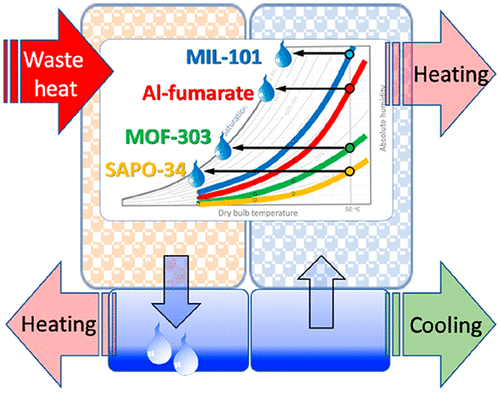当前位置:
X-MOL 学术
›
Chem. Rev.
›
论文详情
Our official English website, www.x-mol.net, welcomes your feedback! (Note: you will need to create a separate account there.)
Water and Metal-Organic Frameworks: From Interaction toward Utilization.
Chemical Reviews ( IF 62.1 ) Pub Date : 2020-05-15 , DOI: 10.1021/acs.chemrev.9b00746 Xinlei Liu 1, 2, 3 , Xuerui Wang 1, 4 , Freek Kapteijn 1
Chemical Reviews ( IF 62.1 ) Pub Date : 2020-05-15 , DOI: 10.1021/acs.chemrev.9b00746 Xinlei Liu 1, 2, 3 , Xuerui Wang 1, 4 , Freek Kapteijn 1
Affiliation

|
The steep stepwise uptake of water vapor and easy release at low relative pressures and moderate temperatures together with high working capacities make metal–organic frameworks (MOFs) attractive, promising materials for energy efficient applications in adsorption devices for humidity control (evaporation and condensation processes) and heat reallocation (heating and cooling) by utilizing water as benign sorptive and low-grade renewable or waste heat. Emerging MOF-based process applications covered are desiccation, heat pumps/chillers, water harvesting, air conditioning, and desalination. Governing parameters of the intrinsic sorption properties and stability under humid conditions and cyclic operation are identified. Transport of mass and heat in MOF structures, at least as important, is still an underexposed topic. Essential engineering elements of operation and implementation are presented. An update on stability of MOFs in water vapor and liquid systems is provided, and a suite of 18 MOFs are identified for selective use in heat pumps and chillers, while several can be used for air conditioning, water harvesting, and desalination. Most applications with MOFs are still in an exploratory state. An outlook is given for further R&D to realize these applications, providing essential kinetic parameters, performing smart engineering in the design of systems, and conceptual process designs to benchmark them against existing technologies. A concerted effort bridging chemistry, materials science, and engineering is required.
中文翻译:

水和金属有机框架:从相互作用到利用。
陡峭的水蒸气吸收以及在较低的相对压力和中等温度下易于释放,再加上较高的工作能力,使得金属有机骨架(MOF)成为有吸引力的,有前途的材料,可在节气的吸附设备中进行节能控制(蒸发和冷凝过程)通过利用水作为良性吸附剂和低品位的可再生或废热来进行热量分配(加热和冷却)。基于MOF的新兴过程应用包括干燥,热泵/冷却器,集水,空调和脱盐。确定了固有吸附特性和在潮湿条件下以及循环操作下的稳定性的控制参数。至少同样重要的是,MOF结构中的质量和热量传递仍然是一个曝光不足的话题。介绍了操作和实施的基本工程要素。提供了MOF在水蒸气和液体系统中的稳定性的最新信息,并确定了一套18种MOF可选择性地用于热泵和冷却器中,而有几种MOF可用于空调,集水和脱盐。大多数具有MOF的应用程序仍处于探索状态。展望了进一步的研发,以实现这些应用,提供必要的动力学参数,在系统设计中执行智能工程,以及概念性的工艺设计以将它们与现有技术进行比较。需要在化学,材料科学和工程学之间架起桥梁。并确定有18个MOF套件可选择性用于热泵和冷却器,而其中的几个MOF可用于空调,集水和脱盐。大多数具有MOF的应用程序仍处于探索状态。展望了进一步的研发,以实现这些应用,提供必要的动力学参数,在系统设计中执行智能工程,以及概念性的工艺设计以将它们与现有技术进行比较。需要在化学,材料科学和工程学之间架起桥梁。并确定有18个MOF套件可选择性用于热泵和冷却器,而其中的几个MOF可用于空调,集水和脱盐。大多数具有MOF的应用程序仍处于探索状态。展望了进一步的研发,以实现这些应用,提供必要的动力学参数,在系统设计中执行智能工程,以及概念性的工艺设计以将它们与现有技术进行比较。需要在化学,材料科学和工程学之间架起桥梁。提供必要的动力学参数,在系统设计中执行智能工程,以及概念性过程设计以将它们与现有技术进行比较。需要在化学,材料科学和工程学之间架起桥梁。提供必要的动力学参数,在系统设计中执行智能工程,以及概念性过程设计以将它们与现有技术进行比较。需要在化学,材料科学和工程学之间架起桥梁。
更新日期:2020-05-15
中文翻译:

水和金属有机框架:从相互作用到利用。
陡峭的水蒸气吸收以及在较低的相对压力和中等温度下易于释放,再加上较高的工作能力,使得金属有机骨架(MOF)成为有吸引力的,有前途的材料,可在节气的吸附设备中进行节能控制(蒸发和冷凝过程)通过利用水作为良性吸附剂和低品位的可再生或废热来进行热量分配(加热和冷却)。基于MOF的新兴过程应用包括干燥,热泵/冷却器,集水,空调和脱盐。确定了固有吸附特性和在潮湿条件下以及循环操作下的稳定性的控制参数。至少同样重要的是,MOF结构中的质量和热量传递仍然是一个曝光不足的话题。介绍了操作和实施的基本工程要素。提供了MOF在水蒸气和液体系统中的稳定性的最新信息,并确定了一套18种MOF可选择性地用于热泵和冷却器中,而有几种MOF可用于空调,集水和脱盐。大多数具有MOF的应用程序仍处于探索状态。展望了进一步的研发,以实现这些应用,提供必要的动力学参数,在系统设计中执行智能工程,以及概念性的工艺设计以将它们与现有技术进行比较。需要在化学,材料科学和工程学之间架起桥梁。并确定有18个MOF套件可选择性用于热泵和冷却器,而其中的几个MOF可用于空调,集水和脱盐。大多数具有MOF的应用程序仍处于探索状态。展望了进一步的研发,以实现这些应用,提供必要的动力学参数,在系统设计中执行智能工程,以及概念性的工艺设计以将它们与现有技术进行比较。需要在化学,材料科学和工程学之间架起桥梁。并确定有18个MOF套件可选择性用于热泵和冷却器,而其中的几个MOF可用于空调,集水和脱盐。大多数具有MOF的应用程序仍处于探索状态。展望了进一步的研发,以实现这些应用,提供必要的动力学参数,在系统设计中执行智能工程,以及概念性的工艺设计以将它们与现有技术进行比较。需要在化学,材料科学和工程学之间架起桥梁。提供必要的动力学参数,在系统设计中执行智能工程,以及概念性过程设计以将它们与现有技术进行比较。需要在化学,材料科学和工程学之间架起桥梁。提供必要的动力学参数,在系统设计中执行智能工程,以及概念性过程设计以将它们与现有技术进行比较。需要在化学,材料科学和工程学之间架起桥梁。



























 京公网安备 11010802027423号
京公网安备 11010802027423号